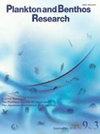日本北海道函馆湾幼海螺(腹足目:海螺科)的捕食偏好
IF 0.6
4区 生物学
Q4 MARINE & FRESHWATER BIOLOGY
引用次数: 1
摘要
幼年日本海螺在野外捕食小腹足类动物。野外最常见的猎物为sangarense Homalopoma,但其密度低于其他猎物(Barleeia angustata, Reticunassa fratercula, Cantharidus japonicus)。为了弄清关节炎乳霉幼崽是否对桑根乳霉表现出“实际的”或“明显的”偏好,我们进行了一次单猎物喂养实验。虽然关节炎乳杆菌比鳗白僵菌和日本乳杆菌更早、更频繁地袭击sangarense,但在袭击频率和潜伏期上,sangarense和兄弟乳杆菌之间没有差异。对桑甘露的攻击失败率高于其他三种,处理时间也明显长于其他三种。处理时间的巨大差异(超过10倍的差异)可能是由于在桑根上存在厚厚的钙质盖引起的。最终,在实验中,关节炎乳杆菌消耗了更多的异乳杆菌个体,而不是sangarense乳杆菌。这些结果表明,关节炎乳霉幼虫对桑根乳霉表现出“实际的”和“表面的”偏好。由于sangarense曾被报道为研究地点的优势种,因此关节炎乳线虫幼体的“实际偏好”可能反映了过去小型腹足类动物的物种组成。本文章由计算机程序翻译,如有差异,请以英文原文为准。
Prey preferences of juvenile whelk Neptunea arthritica (Gastropoda: Buccinidae) in Hakodate Bay, Hokkaido, Japan
: Juvenile Japanese Neptune whelk Neptunea arthritica preys on small gastropods in the field. Although the most common prey is Homalopoma sangarense , its density is lower than those of other prey species (e.g., Barleeia angustata , Reticunassa fratercula , and Cantharidus japonicus ) in the field. To clarify whether N. arthritica juveniles show an “ actual ” or “ apparent ” preference for H. sangarense , we conducted a single-prey feeding experiment. Although N. arthritica attacked H. sangarense earlier and more frequently than B. angustata and C. japonicus , there was no dif-ference in attack frequency and latency between H. sangarense and R. fratercula . Attacks on H. sangarense failed more frequently than on the other species, and the handling time for H. sangarense was significantly longer compared to the other three species. The large difference in handling time (over 10-fold difference) could be caused by the presence of a thick calcareous operculum on H. sangarense . Eventually, N. arthritica consumed more individuals of R. fratercula than of H. sangarense in the experiment. These results indicate that N. arthritica juveniles exhibit both “ actual ” and “ apparent ” preferences for H. sangarense . The “ actual preference ” of N. arthritica juveniles may reflect the past species compositions of small gastropods, because H. sangarense has been previously reported as the dominant species at the study site.
求助全文
通过发布文献求助,成功后即可免费获取论文全文。
去求助
来源期刊

Plankton & Benthos Research
Agricultural and Biological Sciences-Aquatic Science
CiteScore
1.30
自引率
0.00%
发文量
32
期刊介绍:
Plankton and Benthos Research is a peer-reviewed journal publishing quarterly original papers, reviews and notes dealing with any aspect of the biology and ecology of planktonic and benthic organisms and their interactions with the environment in any aquatic system, and is open to all scientists around the world. Submission of a paper is held to imply that it represents an original contribution not previously published and that it is not being considered elsewhere.
 求助内容:
求助内容: 应助结果提醒方式:
应助结果提醒方式:


